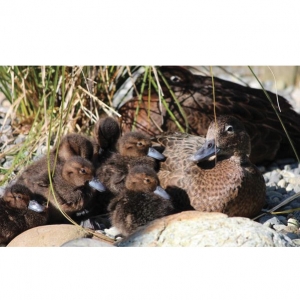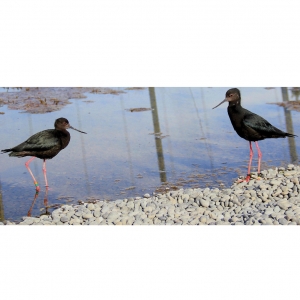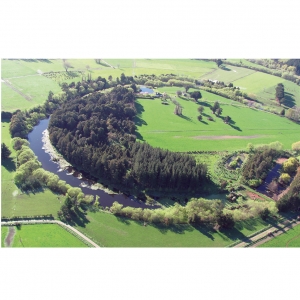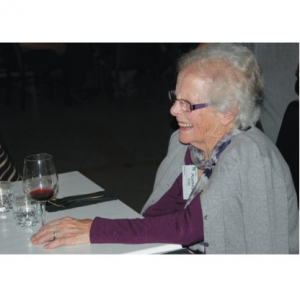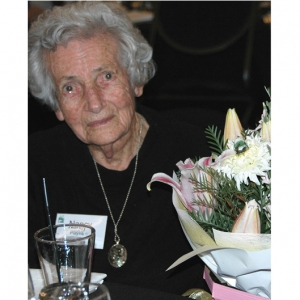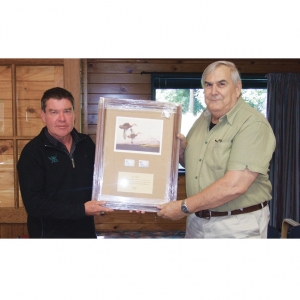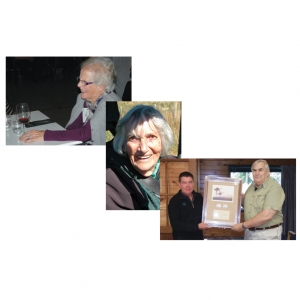Super User
Musings from the Marsh – Habitat te Henga
Having just returned from trip to Southern Africa where brown was in fashion, I was glad to visit our wetland and rejoice in the green of all the wetland and surrounding bush flora. A good year for white also with heketara and clematis splashing through the canopy.
Making my way quietly to the oxbow where I was hoping to see the [almost] resident pair of Pateke I was quite satisfied to instead observe a pair of shoveler, the male in his ruddy breeding colours.Circling upstream to check on some of our plantings of 2-3 months ago I was annoyed to see the billy goats Gruff , all three enjoying the lush spring grass but also no doubt the culprits that had ravaged some of the over 3,000 plants we have planted so far.Especially annoying was the loss of some maire tawake, but perhaps with Myrtle Rust now in New Zealand they are in jeopardy anyway.
Sedges and rushes, flax, kahikatea, the wet loving kaikomako and many other species all planted over several days by school groups, Junior Forest & Bird, Brownies, and volunteers. A group of Rotarians fulfilling Rotary International’s call for every Rotarian to plant a tree to mitigate against Global Warming, managed to do far better including 20-30 large sized kahikatea and pukatea
A large area of flax was planted where the previous owner had allowed a dump of some soil that unfortunately had gorse seeds. This was the only part of our almost year old purchase that had gorse and although sprayed out last summer, seedlings will spring up. However flax is impervious to the spray we can use to steadily eradicate the gorse seedlings and will ultimately shade out gorse.

Special plantings: Sedges and rushes, flax, kahikatea, the wet loving kaikomako and many
other species planted over several days by school groups, Junior Forest & Bird, Brownies, andvolunteers.
Earlier in the month behind the newly planted flax in the small seep curling around to the oxbow, a bittern was seen so they are certainly utilising all of our Matuku Link property from west to east.
Good progress has been made on the nursery that will be providing the many plants needed to revegetate the 3-4 hectares of alluvial flat and that task will probably take 3-5 years. Downstream in the main part of the te henga wetland our trapping contractor often sees Pateke – but a more exciting report has just come through of another missing species.
With an invasion of Salvinia weed tackled by MPI two years ago, follow up monitoring on the water by kayak is ongoing. No Salvinia weed was seen in the latest monitoring but among the birds noted banded rail was listed. We are investigating this further as that species has not
been noted for decades following the collapse of the fitch industry and the local fitch breeder
merely releasing his animals into our valley.
If confirmed this will mean that all the rails are present as last year our audio monitoring picked up marsh crake in almost the same area. As a consequence of that we have beefed up our predator control with a line of Goodnature A24 traps along the shore line.
John Sumich
New hatchings at Pukaha Mount Bruce
September 2017: Pukaha Mt Bruce
Since staff at Pukaha last caught up, the Pateke pair now have six ducklings in their care. The Whio, that live in their free flight aviary have also been sitting on a clutch of five eggs.
Also the first monitored wild kiwi chicks were safely hatched in the reserve. Staff said it was great to see the first conservation breeding of the season had taken place in the new free flight aviary. It is a super sign that the wildlife love this new space as much as the visitors who go to see the new young ones at Pukaha.
Free flight aviary popular at Pukaha Mt Bruce
At Pukaha Mt Bruce staff have been delighted with the way the birds have settled into their new home in the free flight aviary. The whio and pateke are loving their new areas and are not difficult
to spot. The whio are in an ‘internal aviary’ with a new river run while the other birds are all together in the bigger aviary space. Both the pateke and whio are breeding pairs.
The korimako seem to spend all day singing and while the kaka and kereru took a little while to settle in, they are now happy and busy in their new space and are almost oblivious to the visitors
who walk through the aviary.
If you are lucky enough to be at Pukaha at the free flight aviary at around 4pm there could be a ranger talk at the “Final Flight” area. It tells the story of the restoration project for the Pukaha forest and how captive breeding can help to protect and grow our endangered species.
Pukaha Mount Bruce welcomes new General Manager
Pukaha has a new general manager, Emily Court. She started in her role immediately after Labour weekend.
Ms Court moved to the Wairarapa from Christchurch two years ago after spending the previous five years working in a business recovery role after the 2010 and 2011 Christchurch earthquakes. She led a recovery programme for the international education sector which included securing a $5million funding package during her tenure.
Emily has also had previous roles in banking, retail, economic development and international education. Her most recent role has been with the Wairarapa branch of Public Trust as a Professional Trustee and manager.
Ms Court has a business degree from Victoria University, an MBA and also holds a formal project management qualification.
This extensive business background will be a real asset to Pukaha, as they are in the process of planning several new and interesting developments.
Emily is excited about the new role and outside of it, will continue to spend time with her two children in their new Wairarapa home. In their spare time the family enjoys renovating their old bungalow in Carterton, riding their horses and exploring the North Island.
Welcome to the Pukaha team Emily
4/12
General Manager: Emily Court is now into her new GM position
Spring Has Sprung
The 2017/18 breeding season has begun and The Isaac Conservation and Wildlife Trust (ICWT) once again reached its busy rearing phase.
Early October saw the collection of the first clutch of critically endangered New Zealand shore plover eggs for artificial incubation. Critically endangered black stilt/kaki pairs had also begun laying eggs.
ICWT is happy to report that three clutches have been incubated by critically endangered orange-fronted parakeet breeding pairs, as well as eight healthy chicks presently being raised. (see page 9).
The first South Island blue duck/whio ducklings hatched, while North Island ducklings hatched soon after. Meanwhile five brown teal/pateke pairs have hatched ducklings and more will be on the way.
ICWT’s reptiles are becoming more active with the warming weather, meaning tuatara, Otago skinks and grand skinks will be breeding as well.
As always, ICWT’s ambitious native planting programme across the Isaac Conservation Park and the Otukaikino River restoration site continues; while salvaged historic buildings continue to be restored to their former glory in the Heritage Village.
For more information see:
http://www.isaacconservation.org.nz/
https://www.facebook.com/ICWTNZ/
Sabrina Luecht,
Wildlife Project Administrator,
ICWT
A unique New Zealand wetland enhancement project
In 2008 Taumata Lagoon, south east of Carterton in the Wairarapa Region of New Zealand, was classified as “A WETLAND OF NATIONAL IMPORTANCE”.
The lagoon is also recognised as the country’s best example of an “Oxbow Lagoon” – with both ends of the lagoon being only 300-metres apart.
In addition, the inner area of the lagoon contains between 200 and 250 ancient Totara and Kahikatea. (Possibly the most significant area of ancient forest on the floor of the Wairarapa valley).
The 34-hectare lagoon environment is also the home of over 40 different species of birds – including good numbers of the rare and endangered endemic NZ Dabchick, large numbers of NZ Shoveler, Grey Teal and Black Swan (there are now close to no mallards!), plus bush birds, including: Falcon, Kereru, Tui, Bellbird and huge numbers of Fantail.
In addition 110 different species of endemic plants have been identified in the area.
Taumata Lagoon
A wetland of national importance and a classic oxbox lagoon, with close to half of the lagoon and its environs being protected by a QEII National Trust Open Space Covenant.
The lagoon is 9 kilometres south east of Carterton – a rural town in the Wairarapa region of New Zealand.
Sylvia and Neil Hayes purchased part of Taumata Lagoon in 1990 and since then considerable enhancement of the environment has taken place, and, with lots of dedicated assistance, a weir to regulate water levels was constructed, well over 5000 willows have been removed, over 8000 Totara, Kahikatea and swamp flax have been planted and several thousand predators have been eliminated; with management of the predator control programme being carried out by the Greater Wellington Regional Council since 2000. The Timms trap was originally designed as a Possum trap, but has proven to be highly successful in the elimination of – feral cats, ferrets, stoats and hedgehogs. The largest ferret ever eliminated in New Zealand was in a Timms trap – at Tamata Lagoon.
Historically the most desirable lagoon water levels have relied heavily on flood water from the adjacent Waiohine River, but in 2014 a Waiohine River stop bank burst its banks – the result being that flood water pours through the gap and heads straight to the Ruamahanga River – instead of the lagoon!
The Waiohine and the Ruamahanga rivers converge three kilometres to the south of Taumata Lagoon and each river floods 3 to 4 times each year.
The Regional Council informed the four owners of Taumata Lagoon that they had no funds available to rebuild the stopbank – and the owner of the stopbank property said he didn’t want the stopbank rebuilt!
At my instigation, on September 14, 2016, a meeting was held on site to discuss how best the problem could be resolved. Involved were GWRC staff, the four lagoon owners, the Wairarapa QEII National Trust representative and the landowner of the stopbank area. With full support of all involved the outcome of the meeting was to reverse the flow of water through the adjacent neighbours flood drainage channel (which normally puts flood water back into the Waiohine River), construct a culvert under the road, construct a channel on the Hayes property and join it up with the culvert.
In 1942, in the same area, there were large numbers of endemic Totara (Podocarpus totara) and the endemic Kahikatea (Dacrycarpus dacrydioides), but all but seven of the Totara were milled during the 1950s.
This aerial photo was taken in 1942.
The area just above the gravel road at the bottom of the photo is where Suez #2 was created and where our final planting programme was completed in August 2017.
Many of the Totara and Kahikatea in the main part of the natural forest were also milled at the same time, but approximately 100 Totara and 250 Kahikatea survived and many of these have a QEII National Trust Open Space Covenant over them, which protects them and all plantings since 1990 in perpetuity. Most of the Totara and Kahikatea are ancient – with massive trucks!
Close to 50 different species of birds have been identified in the lagoon area and over 100 endemic trees and plants have
been identified.
The Hayes block of land where the “Suez #2” was created was leased to a neighbour for 10 years, but as soon as the lease expired Neil and Sylvia Hayes commenced another major native planting programme – initially with native swamp flax (for shelter belts) and then Totara.
Between 1990 and 2017 Neil and Sylvia have proven the ancient Greek proverb to be wrong: “THE WORLD GROWS BETTER WHEN OLD PEOPLE PLANT TREES KNOWING THAT THEY WILL NEVER SIT IN THEIR SHADE.”
All finished five days later – with grass seed spread throughout the flat ground. The flow of water from the neighbours drain was reversed – and instead of the water flowing back into the Waiohine River it now flows into Taumata Lagoon.
NZ Swamp Flax grows rapidly and provides an excellent wind break for other endemic plants and trees – and for the endemic Tui (Prosthemadera novaeseelandiae), Bellbird (Anthornis melanura) and the native Fantail (Rhipidura). The NZ Native flax provides an array of insects and nectar.
The first flow through the canal and into the lagoon was in April 2017.
Summary
A superb outcome to a complex wetland management problem.
Sincere thanks to the GWRCs Masterton Branch; the GWRC Head Office, all five landowners involved, particularly the adjacent neighbours – the Herrick Family – for their essential support with the use of their drain and the QEII National Trust for their support.
If further information is required please contact Neil Hayes on (06) 3796692 or by Email on This email address is being protected from spambots. You need JavaScript enabled to view it. – or at PO Box 188, CARTERTON.
Neil Hayes
QSM CEnv DU (NZ) Foundation Member & DU (NZ)
Life Member.
Audrey Pritt – Always had a smile
Obituary: Audrey Pritt
Audrey Eleanor Pritt, born 2 January 1926 in New Plymouth, in the same month as George Martin who became the Beatles producer, and the German airline Lufthansa was formed.
Audrey died on 4 September this year, aged 91. She moved to Ohakune at 6 years old – her father working at the Post Office at Ohakune Junction. Audrey attended school in Ohakune, learned piano from the local nuns and highland dancing with her sister Anita, later entertaining American troops at the Junction.
After leaving school she worked in the Railways telephone exchange at the Ohakune Junction Station.
She went on to hairdressing school in New Plymouth, then took up her first job in Taihape, returning to Ohakune in 1948 to start her own salon. Audrey met Bill Pritt and they were married in 1951, moving to the farm on Smiths Road. With no electricity there at the time, she used a copper to do washing, a “Mrs Potts” iron and Coleman lamps for lighting.
The couple raised three daughters on the farm, Christine, Di and Lois. Audrey was involved in many community activities, including pantomimes where she played the piano for the Women’s Division of Federated Farmers choir.
She also served on the WDFF committee including as president. She was a keen golfer, winning the Junior Championships in 1967 and was made a life member of the club. She still played social golf into her 88th year, and served in most positions on the Club committee.
As a keen gardener she was a regular winner at flower shows including winning the Camelia Cup five times at the Waimarino Flower Show.
She was a member of the Waimarino Wine Club and worked with daughter Di in the Waimarino Wines from 1988 until 1993.
Audrey also worked at Bucks Drapery from 1966 until 1971. Though throughout her adult Audrey. life she worked on the farm, first with Bill until his death in 1989 and also with Di mostly feeding calves. During her time at Ohakune she witnessed two major eruptions of Mt Ruapehu, the first in 1945 and then again in 1995-96.
A service was held for Audrey at the Waimarino Golf Club on 11 September this year, attended by countless family, friends and golfing partners.
Obituary courtesy of the Ohakune Bulletin
Gone but not forgotten
48 hrs ago we lost our Mum
That is the only time I can ever say that.
There is only ever the one Mum and there are no second times. It’s a strange concept and feeling that began in our case in 1923 when Mum’s life first began. In that time since, she has seen the effects of the Great Depression, the rise and fall of the hundreds of local Dairy Factories across New Zealand, the demise of steam trains and the rise of diesel and electric versions, the disappearance of trams, the popularity of international air travel, TV both black and white and colour, Kindergartens, draining of swamp land for farming and the return of same to wetlands, wars in Europe and
Asia and the absolute freedom to visit both (a trip to China with Pukeiti members), the fun of US Soldiers on Furlough in NZ and herself being able to travel there and to Canada, paper and paper-bags for everything then to plastic and back to paper. I could go further....but you get the idea.
In 93 years Mum covered a lot of ground. From humble beginnings in Ness Valley, South East Auckland and Waharoa, Waikato to a young employee in The Post Office at Waiuku. Meeting a young soldier Ross Payne from Palmerston North who was still on active service. Being Mum to 4 boys and 2 girls can’t have been easy. I was there!
Yet she still had time for us all at and about school, Scouts and Guides, sports etc. Time for active involvement in The Free Kindergarten Assn for many years including representing NZ at International Conferences. Time for the Clerical Workers Union....meetings in Wellington. Secretary at Papakura East School followed by similar at Auckland University where she typed theses for a young Peter Sharples who became Dr Pita Sharples among many others no doubt. A stray kitten found at the said University House on Alten Rd was dopted and lived with Mum for many years, known as Alten....there’s a picture of him in the lounge!
During this time there Mum gained her Bachelor of Arts Degree at age 63. This followed passing her drivers licence a couple of years earlier. Age was no barrier. By now she was a member of The Auckland Entymological Society, Railways Enthusiasts, Forest & Bird (gained the “Old Blue” Award here), Pukeiti Rhododendron Trust, Ducks Unlimited and a supporter of a number of charities. With Ducks Unlimited Mum took a trip to North America/Canada...who are these people you ask? A fabulous group of people who are active conservationists...check them out! The Leprosy Mission also received her support.
By now she is living in Howick and actively involved with the Elim Church. Here she completed a three year course in religious studies.
After an incident in a 4wd on a trip in Northland, she suffered from an uncontrolled head shake and her health was average. After starting the best nutritional supplement programme on the planet this disappeared and her health improved. She demanded these right till the end, knowing her eyesight degradation had stabilised as well.
Over a period of 25 years or more, she organised and ran day trips and major tours around NZ for the Forest & Bird Auckland Branch. These often required complete traverse (by car) to plan and book accommodation and highlights for the attendees. Mum’s friend Rose, whose eyesight was very poor, would accompany her while sorting out these trips. Steve and Christine were the bus driving couple on most of these trips and became lifelong friends. In latter times Mum would phone Rose and read her the newspaper as Rose could no longer do so.
We suggested Mum come to Taranaki with us where we could give closer support and there were now more family members. So at age 89 she moved to New Plymouth spending six months with us while she purchased her house in Fitzroy and redecorated it. Selling Pinewood Grove, Howick, was interesting. Sold by auction, it created huge interest and sold at well over expected price. She didn’t believe me when I told her the price and several neighbours instantly threatened that they also were going to sell!
Not content to do nothing, Mum went on a train trip of the North Island, attended two national AGM’s of the Ducks nlimited, Taupo and Martinborough, joined the Knox Presbyterian Church at Fitzroy and a few Pukeiti and Forest & Bird meetings in that time.
While it sounds as though all of these things are a singular effort, of course this is not so. In every case there were always other people who made Mum’s life what it has become. To all those people we say “thanks”. Not just for the big obvious things but many times those small unseen, unnoticed things that make up the matrix of life. For example the ladies who form the immediate neighbourhood... took out the rubbish, who would drop in for no reason, who noticed if the curtains remained drawn when they should be open....thank you. For the staff at Sporty’s who would walk Mum across the road or deliver the hot meal if it was raining. These are the things that make a life.
To the grandchildren and great grand-children who would drop in and visit.
The last group of people who deserve great thanks are those staff of the Taranaki Base Hospital and Tainui Palliative care. From the Ambos, to cleaners, to the Doctors, to the nurses to everyone who showed such great care, a real salute and thanks.
And so a circle of life closes...
And so more begin. Children, a posse of Grand-children and a growing number of Great-grand-children are here because...
Mum has left a legacy of which she can be truly proud. Did she do it on her own? Of course not. But she did enough to make a difference and that truly constitutes a legacy of which I am very proud.
David Payne with thanks to Sheryl PS. of course it is more than 48hrs ago....but that is when I started the story.
Since I wrote this initially we have held the Funeral for Mum. It was a really nice event of which she is most proud, I am sure. Friends and family came from all over. John Cheyne as President of Ducks Unlimited came and spoke. A wee touch noted by many was that he left a DU cap on the casket which Mum is wearing now. Mum was laid to rest in Inglewood Cemetery beside her Grand-father. Forty mainly family members attended the graveside ceremony.
A sub-note....Mum had a penchant for the understatement. Having been aware of her membership of Ducks Unlimited for many years, we thought it this obscure group with connections to Canada who shot ducks! In taking Mum to the last three DU Annual Conferences I learned the truth. It is way bigger and such a great group of people. As a consequence of John C. coming to the funeral, Dr George Mason wishes to liaise with DU with a view to co-operating on a research project he is funding!!
David Payne
QSM for DUs first president Ian Pirani
Ian received a Queen’s Service Medal (QSM) in that year’s Queen’s Birthday honours for services to conservation.
In 1974 Ian was a co-founder of Ducks Unlimited and was the first president of DUNZ until 1980. During that time Ian and his wife Dawn initiated a Pateke breeding programme and nesting boxes for Grey Teal throughout NZ.
Ian and his wife Dawn established the largest water fowl collection in Australasia, and were the first to privately breed Whio in captivity.
Originals and stalwarts – strong and resolute
Ian was a great guy
I met him at one of the Wellington Acclimatisation Society branch meetings around 1966. He and Dawn lived at Pauatahanui on a few acres – right next to Dawn’s brother’s farm of close to 400 acres.
In 1969 we decided to establish a pheasant breeding and shooting club – called THE WILLOWGLEN GAME IMPROVEMENT ASSOCIATION. It was a 10 person syndicate and in no time at all we built – an incubator room, a brooder room, two hardening-off aviaries and then a 10,000sq ft aviary where the birds learnt to become wild and how to feed from purpose built aviaries.
We had a breeding permit from the Acc Soc, but were not allowed to shoot hen pheasants – but we could kill them by other means! So, the syndicate took-over the WGTN ACC SOC COUNCIL– in a very short space of time! I represented DU for 15-years, syndicate member Don McCulloch soon became President – retiring from the Council 26-years later! Two other syndicate members – Paul Pirani and Peter McLeod were also on the Council for many years. And in a very short time we were allowed to hunt hen pheasants.
The average number of pheasants reared for release was between 350 and 400 each season. We released them on the 40-acres and had to hunt them every weekend. In no time at all the whole of Pauatahanui was full of pheasants!
Sadly it all came to an end in 1974 when Ian and Dawn sold up and moved to Hamilton with Ian’s job. 1974 was also the year DU was founded – at a meeting held in Stratford; with Jack Worth, Trevor Voss, Ian, Paul and me. We went very quickly from no members to 100’s.
For many years our middle of the year DU Board meeting was held at the Pritt Ranch at Ohakune – on the second weekend of the duck season!
Bill Pritt was also a legend and one who created between 40 and 50 wetlands in the Ohakune/Raetihi area, with great encouragement from Audrey and Di. Bill was also a great duck hunter who took the “DU TEAM” to all the best spots.
Neil Hayes
DU has lost three stalwart members
Recently in the last couple of months, Ducks Unlimited has lost three stalwart members.
They are Ian Pirani, Nancy Payne, and Audrey Pritt. You will find their obituaries, along with photos on pages 3 to 5 in flight magazine.
Nancy Payne one of the oldest members of DUNZ will be missed, always had a smile, and loved the chance to talk and catch up with the gossip.
Audrey Pritt, another well know and long time member of DUNZ was renowned for her cooking, for her happy smile, and always ready for a chat.
Ian Pirani should be remembered by all members. He was the first President of the DUNZ.


